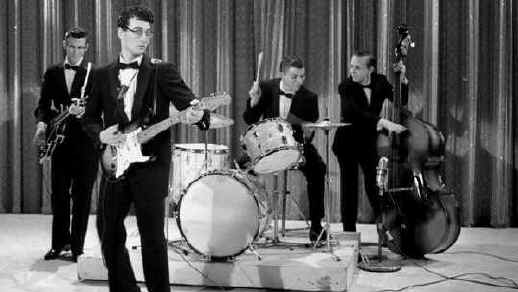
(L-R) Niki Sullivan, Buddy Holly, Jerry Allison, Joe B. Maudlin
Buddy Holly and the
Crickets

(L-R) Niki Sullivan, Buddy Holly, Jerry Allison, Joe B. Maudlin
One of the two great singer-songwriter
guitarists of the'50s ( the other being Chuck Berry), Buddy Holly
was probably the first rock and roll artist to concern himself
with virtually every aspect of his music including arranging and
record production.
Members:
Buddy Holly - lead vocalist and guitarist
Niki Sullivan - rhythm guitar - replaced by
Tommy Allsup in 1958
Joe B. Mauldin - bass
Jerry Allison - drums
![]()
Real Audio Interviews
|
|
|
|
Charles Hardin (Buddy) Holly was born September 7, 1936 in Lubbock, Texas the fourth of four children born to Lawrence and Ella Holly. In Texas most everyone had a nickname, and the family always called him "Buddy." The Holly's had a rich musical tradition. Older brothers, Larry and Travis, taught themselves how to play the guitar. Their sister Pat sang duets with her mother in the evening at the living room piano. Every Sunday found the Hollys attending services at the Baptist Church, singing hymns of praise and joy to God.
|
|
|
Lubbock "The City of Churches," was conservative and segregated. In his youth, Holly had little direct contact with blacks or their music, but like so many other young musicians, he was attracted to the rhythm and blues heard on distant radio stations.
At age eleven Buddy began taking piano lessons, but soon switched to the steel guitar After 20 lessons he switched to acoustic guitar. Although his formal music education was short, Buddy was familiar with many kinds of music. Thoroughly imbued with the blues and country sounds he heard on the radio at a early age, Buddy won five dollars at age five singing "Down the River of Memories" at age five.

In 1951 Buddy met Bob Montgomery, a fellow seventh-grader at Hutchinson Jr. High, who also played guitar and sang country songs. Montgomery's taste in music ran to country music, especially Hank Williams, and Montgomery would be a major influence over Buddy's choice of music.
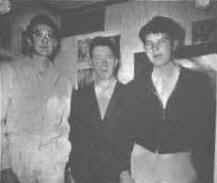
Billing themselves as "Buddy and Bob," they played
junior high assemblies and local radio shows. Their sets were
basically country, beefed up by harmonies and their own guitar
accompaniment. Buddy and Bob became Lubbock's leading performers.
They soon added Larry Welborn to play bass.
In the early fifties with high school friends he played in a
country oriented Western and Bop Band. Between 1950 and 1952,
they performed at local clubs and high school talent shows,
sometimes adding a bass and, less frequently, drums. Harmony
duets still predominated their style, with Bob usually singing
lead. When Buddy occasionally would sing lead, you'd hear a more
upbeat tempo, a less country sound and another forecast of things
to come.
|
|
|
|
By the time Buddy and Bob entered high school,
they were widening their audience by appearing at youth clubs and
centers as far away as Carlsbad, New Mexico and Amarillo, Texas.
Lubbock's "Cotton Club" and "Bambaloo Club,"
the Union Hall in Carlsbad and Amarillo's "Clover Club"
all featured "Buddy and Bob" performing music they now
dubbed as "Western and Bop." Local radio stations also
gave impetus to Buddy and Bob's career. KDAV, the nation's first
all-country radio station, held a weekly "Sunday
Party," patterned after the highly successful "National
Dance Barn" show on Chicago's WLS. Buddy and Bob were
frequent guests. In fact, their popularity grew so much they were
given their own half-hour program each Sunday. Their repertoire
remained basically country with Bob Montgomery still singing
lead. But as 1954 progressed, Buddy began to sing more blues and
"bop" numbers on the show. Although Montgomery was the
principal composer during their partnership, Buddy also began to
write. Two of these three songs were "Heartbeat" and
"Love's Made a Fool of You," both recorded several
years later.
But it wasn't a keen-eared record company that brought Buddy his
first real break. It was that good old local radio station, KDAV.
In addition to airing the "Sunday Party," KDAV also
sponsored live country and early rock 'n' roll concerts in
Lubbock. The station often chose the "western and bop"
duo to open the shows, which headlined stars like Ferlin Husky,
Marty Robbins, Porter Wagoner...even Elvis. And Buddy met them
all. One of these performances played a crucial role in the
advancement of Buddy's career.

That October the group added Jerry Allison on the
drums. October 14, 1955, Bill Haley and the Comets starred in a
show at the Fair Park Auditorium with Jimmie Rodgers, Hank Snow
and "Lubbock's own Buddy, Bob, and Larry." Eddie"
Crandall, Marty Robbins' manager, booked the show.
The show's promoter Eddie Crandall was impressed by Buddy's
performance and told Holly he would attempt to get them a
recording contract. In January of 1956, Buddy was offered a
contract from Decca Records. The only hitch was that they were
interested in just Buddy. Montgomery insisted that Buddy go it
alone, Welborn stayed in Lubbock to finish high school.
Holly returned to Lubbock where he played locally with stars that came through the area. On June 3, 1955 Buddy and Bob opened for a young Elvis at Connelly's Pontiac Showroom, in a free show to attract customers. After that gone was the country music, replaced by pure rock and roll.
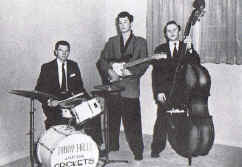
He signed a contract to record country music on the Decca label in 1956. The first session was in Nashville on January 26, 1956 and held at Owen Bradley's recording studio. Don Guess, another Lubbock boy, played bass and with Sonny Curtis on lead guitar. Drummer Allison, still in high school, sat in for only one session. Holly recorded a number of records that went nowhere. Among them was "That'll Be the Day" that in rock version would be a hit. At this time Holly began writing. One of the songs "Cindy Lou" which was to be one of his biggest hits. It would later be renamed "Peggy Sue" at the suggestion of band member Jerry Allison. Peggy Sue Gueron was Allison's girlfriend future wife.
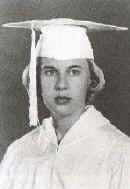
Peggy Sue Gueron's high school yearbook
picture
Buddy wasn't allowed to play the guitar as Bradley thought it made the recordings to difficult. Among the four songs that were recorded was "Blue Days, Black Nights" which would be Holly's first single. On the label his name was spelled "Buddy Holly" for the first time. Reviewed favorably in the trade press, the record did not do well in the marketplace. The disc did not succeed partially because Holly and the Decca-selected backup group could not create the tightness inherent in the union of Holly's voice, his guitar and his own group of musicians.
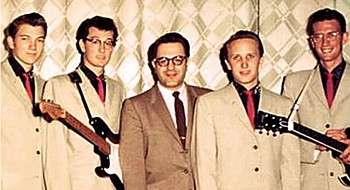
February 25, 1957 Holly and the newly named Crickets recorded the rock version of "That Will Be the Day" at Norman Petty's studio in Clovis, New Mexico. These tapes were sent to Roulette. The company liked Holly's songs but not his group. They felt they didn't need another artist like their current rock 'n' roll stars, Buddy Knox and Jimmy Bowen. They were interested in Knox recording "That'll Be The Day," and Bowen cutting "Lookin' for Someone to Love." But Buddy Holly wanted to record his own songs with his own group, now called the Crickets.
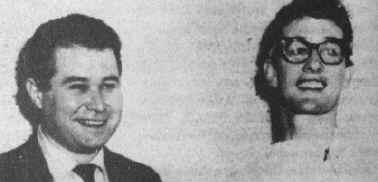
Petty suggested sending the demos to Peer-Southern, a New York publishing house where he'd placed some of his own compositions. Peer-Southern gave the demo to Bob Thiele at Brunswick Records, a subsidiary of Decca. Thiele liked what he heard so much that Brunswick decided to use it as a master.

(Unidentified man, Jerry Lee Lewis, Phil
Everly and Buddy Holly)
Because Decca had the original "That'll Be the Day" it was determined to be unwise to use Holly's name in the credits. Grabbing a dictionary they searched for an appropriate group name and decided to release the song as the Crickets. "That'll Be The Day," recorded by The Crickets, was released in June, 1957. Initially sales were slow but, by August they were increasing and it began to appear on the national charts. A month later "That'll Be The Day" was one of the best selling records in both the rock and roll and R&B markets.
|
|
Petty became the groups manager and producer. At Petty's insistence, the Crickets signed with Brunswick as a group, while Holly signed as a solo with with Coral. Petty saw in Holly a potential for superstardom. The strategic attempt at double exposure would pay off later.
|
|
In June, 1957 Brunswick released "That'll Be The Day" by the Crickets while Coral released "Words of Love" by Buddy Holly. Only "That'll Be The Day" caught the public's ear. "Words Of Love" was recorded by the Diamonds and beat Holly's version onto the streets by three weeks.
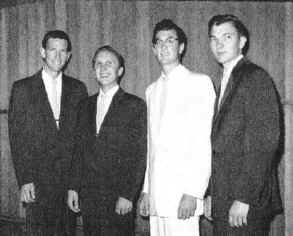
Niki Sullivan, Joe B. Mauldin, Buddy
Holly, Jerry Allison in Clovis
Initial sales of "That'll Be The Day" were slow. Through the summer of 1957, it's popularity moved from the Southwest to the West Coast and back to the Northeast. By early August the record began appearing on the national charts. Four weeks later "That'll Be The Day" was the top selling record on both the pop and R&B charts.
In August, the group began playing the east coast theater circuit, the Howard in Washington, the Royal in Baltimore and the Apollo in New York City. For one week at each venue, the Crickets quickly won over the predominantly black audiences with their energetic stage show.
Buddy Holly Real Audio Interview
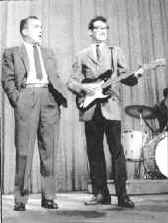
For the next year it seemed like either Holly or the Crickets cut a hit record every other month. At the same time they were touring extensively with Alan Freed shows. They also made their television debut on "The Ed Sullivan Show".
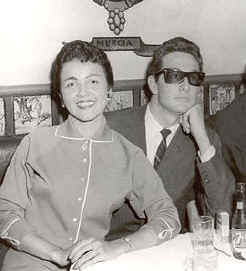
Buddy and Maria Santiago
In October Holly split from Petty over a failure to account properly for the groups earning. In November, 1958 the Holly and the Crickets returned to Lubbock. Record sales had fallen off as Buddy changed to from hard driving rock and roll to a lighter style. The other Crickets didn't like the direction that their music was taking. Holly was convinced he was taking the right direction and split with the Crickets when they decided to stay in Lubbock and continue working with Petty. He moved to Greenwich Village, NY where he married Maria Santiago. Back in New York he recorded in January, 1959 "It Doesn't Matter Anymore"on the Coral label.
The Crickets continued with guitarists Sonny Curtis, Joe Maudlin, and Jerry Allison, and a succession of various vocalists. After a period back in Clovis recording for Petty and sessions in New York City by 1959 their base was in Los Angeles. Vacillating between the Holly sound and following their own impulses, creating a direct, uncomplicated pure pop sound that virtually eliminated all black elements and country elements as well.
|
|
L to R: Waylon Jennings, Jerry Allsup, Buddy Holly on stage at thw Winter Dance Party |
The split with Petty caused legal problems, tied up his money and Holly found himself in a situation where he needed to tour to pay the bills. He put together a backup group consisting of Tommy Allsup, Waylon Jennings and Charlie Bunch and early in 1959 he joined The Winter Dance Tour Party of the Midwest.
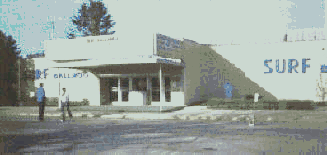 |
|
|
Buddy's last performance was at the Surf Ballroom in Clear Lake, Iowa February 2, 1959. Tired of riding the bus and needing to get his laundry done Holly charter a Beechcraft Bonanza to fly him, J.P Richardson (The Big Bopper) and Ritchie Valens to the next stop Moorhead, Minnesota. On February 3, 1959 the plane took off and crashed minutes later killing all on board.
|
|
The Holly sound was a strong influence into the 60s, carried by the Crickets, Bobby Vee, Tommy Roe's "Sheila" (1962), the Bobby Fuller Four and numerous cover versions of Holly's songs.
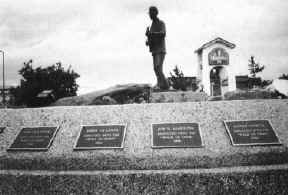
Buddy Holly Real Audio Interviews
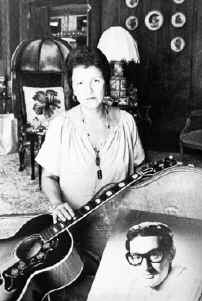
Buddy Holly was voted into the Rock and Roll
Hall of Fame in 1986
The Crickets were voted into the Rock and Roll
Hall of Fame in 2012
The
Crickets
We'll
Always Remember Buddy Holly
Buddy Holly's Death certificate